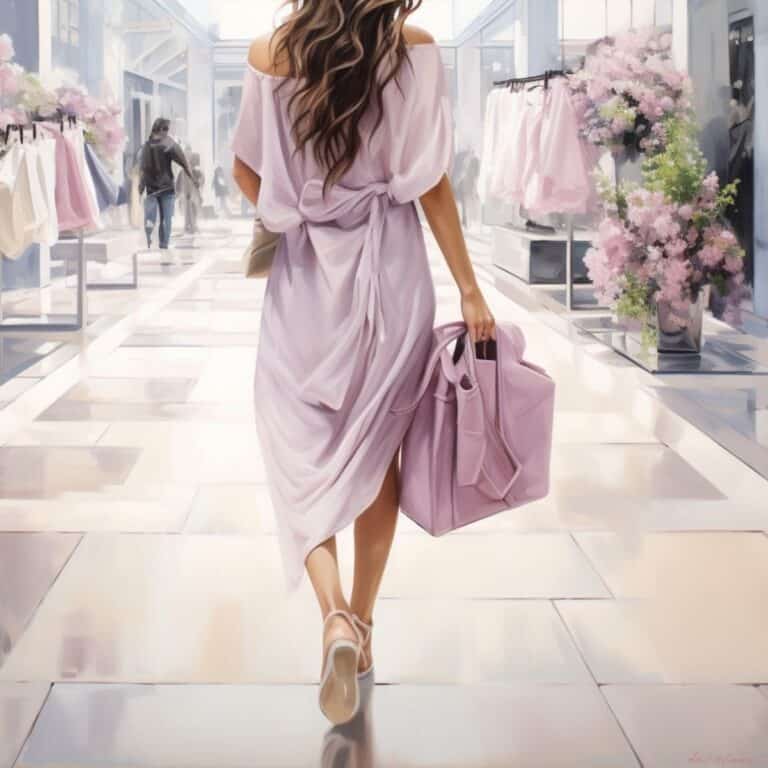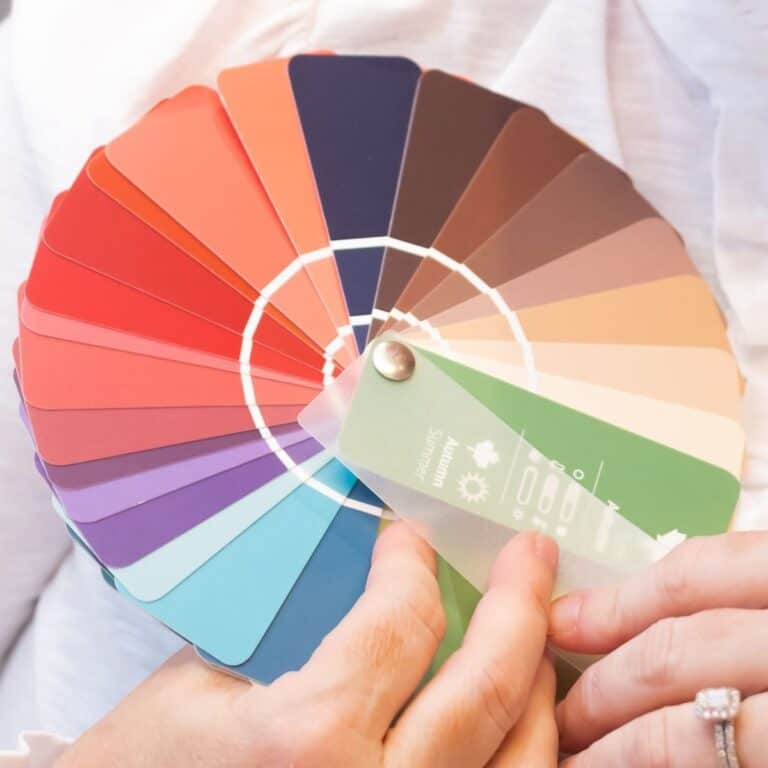Let’s debunk some myths when it comes to determining your skin color undertones as you figure out your color season.

Have you been learning about color analysis and struggling to figure out if you are warm, neutral, or cool?
We’ll keep listening because, in today’s episode, I’m going to debunk some myths about undertones, warm versus cool as far as color analysis goes, and tell you the real tips that you need to know to figure out this crucial answer to determining your color season.
Color analysis is one of my favorite things to talk about because it truly is so foundational and transformative when it comes to your wardrobe.
I don’t know another system of categorizing style that has as many benefits and will give you as many quick wins as color analysis will do for your wardrobe. It trickles into every area from what clothes you wear to how you shop, to how you declutter, and how you organize your closet. It transforms so many things.
I can remember when I was first introduced to the 12-season method of color analysis. I actually kind of knew about this system of colors and style vibes before then.
When I first started learning about seasonal color analysis, I remember that one of the things I struggled with so much was being neutral and not being either truly warm or truly cool enough to be able to say quickly that I was definitely a cool season or definitely a warm season.
As I was combing through articles and blog posts and websites, I kept coming across some advice that is what I consider at this point really bad.
The top one that I hate the most, and almost always refute this when I see it in any Facebook group or any online platform, is that you can use your vein color to determine whether you’re warm or cool. This just isn’t something that exists in color analysis.
I see this idea all over the place when it comes to choosing makeup and in this area of cool versus warm as well. This is my number one least favorite myth, wrong thinking thing about color analysis, but I think that it illustrates a lot of the misinformation that’s really out there when it comes to determining our undertones of whether or not we’re warm or cool or truly a neutral.
Today in this episode, I would love to talk about what these things mean, how they go together to make up the different seasons of warm versus cool, why the vein thing is terrible, and a great tip that you can use to actually help you figure out whether you’re dealing with cool undertones or warm undertones.
Now, before we get into the specifics of undertone, overtone, cool versus warm, I want to make sure that we’re on the same page here. There are a couple of different models and methods of doing color analysis, but the way that I do analysis and the way that I think that is done best is that your color season rests solely on your skin and how it reacts to color.
Table of Contents
Skin Color Undertones: Why Skin is the Primary Determinant of Season
A lot of times when you see things online, you’ll have to answer questions about your eye color and your hair color. The truth is that your hair color has zip, zero, and nothing to do with your color season whatsoever. I do not take hair into account when I do analyses. I don’t teach it in any form, fashion, or way.
I have seen blonde winters and I have seen caramel-colored deep autumns. I have seen light summers with brunette hair. Hair has nothing to do with it. So let’s just go ahead and take that one off the table.
Skin is the primary determinant. I will say when it comes to eyes, I’m not an advocate that eye color is a determinant of your season. However, the patterns in your eyes are a good correlation to your season. When I say that, I’m going to give a really quick overview here.
If you want to go deeper I have a longer blog post about this. The patterns in your eyes are actually as unique as your fingerprints, which is really cool if you think about it.
Once you start looking at people’s eyes, you’ll see that each eye is so individual and so unique. When you start to really study the patterns, you’ll see that what you think is just a blue eye can be an eye comprised of blues and greens and yellows, and several different colors.
But within all these colors, there are patterns that emerge and there’s typically a base pattern to the eye and then several overlay patterns. Each one of these correlates with a specific season.
The way that I use this is to look at the eye and see what patterns are in the eyes. If I see an eye that has a spring pattern and a summer pattern, there’s a pretty good chance that there’s going to be spring or summer in their season.
It doesn’t necessarily mean they’re a spring or a summer. Summer influence could mean that they’re a soft autumn, for example, because that’s an autumn leaning into summer. So the eye patterns don’t tell you the season, but they can help you point in a direction to start narrowing things down.
Skin Color Undertones: In-person Versus Photos
Let’s go back to this whole skin thing.
Your skin is the primary determinant of your color season. It indicates whether you’re warm or cool. It shows how much value your skin can handle in the range of light to dark. It also shows the level of chroma that you have, whether you are bright or muted. This is the reason why when it comes to seasonal color analysis in-person draping is the gold standard.
Of course, I teach this in a virtual process and I stand by my virtual process because it doesn’t rely on just photos. That’s why some of those online drapes that you see on different apps that you can use to put a circle around your face, really aren’t accurate because they’re only taking into account this one feature, which is a photo of yourself compared to colors.
But photos aren’t completely reliable. The colors in the photos can be different depending on whether or not you use the back camera or the front camera of your phone. They can differ based on what time of day you took it and what kind of light you’re standing in. There’s really no way for you you to tell if this is a good photo for analysis or not if you’re just a layperson.
Photos can be used for analysis as long as you’re looking at a holistic process that looks at some other areas to determine what we’re looking at. I teach this very much in depth in my DIY color analysis course. We don’t start with a photo. You do use a photo and those digital drapes like a lot of these apps you see, but it’s the last step and it’s after you narrow down through a bunch of different other filters.
That’s really the best way that you can do a virtual analysis is by using multiple methodologies, and multiple different areas to narrow down what’s going on with that individual person.
When it comes to skin, we have a range usually as far as warmth, and we call this hue and color analysis. You typically have warm people, cool people, and then a lot of people who are neutral.
In North America, the distribution of people is something like 34% of people are a pure season, and that would be warm spring, warm autumn, true summer, and true winter. These are people that are definitely warm and definitely cool and don’t really have any neutrality, but the other 68% of the population is in that neutral category. Usually, when you have a neutral person they lean either warm or either cool, but it can be really hard to tell.
And there are a few tricks to help you figure those out. I’m going to share my favorite one with you here at the very end of this, it’s going to be my very last tip of the day, but I want to talk about how skin functions in the realm of color analysis. So your skin essentially has what we call undertones and it has overtones.
Skin Color Undertones: Vein Color
When we’re looking at color analysis, we’re looking for the undertones to determine your season. This is where that whole vein thing comes from. People think if you can tell the color of your veins, you can tell what your undertone is, but the reality is that your vein color is actually being hidden and affected by your overtones.
A lot of times makeup is actually something that people put on based on overtones as well. When we talk about undertones and overtones it’s really just kind of one way to look at it. When you have undertones, you essentially have two undertones. You have a red undertone, which is people who are warm, and you have a blue undertone, which is people who are cool.
If you think about this like basic primary art color mixing, you’re looking at putting an overtone on top of an undertone and you get several different overtones. I’ve seen pink ones and beige ones.
People who are a winter typically have no overtone. It’s almost a colorless white type of overtone leaning into gray. You can have a violet overtone. Yellow is actually a pretty common overtone as well.
I see this one most often on people who have a blue or cool undertone, and this is where you get an olive complexion. Ironically, olive-complexed people are almost always cool in their undertone because we’re thinking about that blue and that yellow which makes the green.
When you begin to think of the combinations in this way, you could see how it can get confusing. Because if you have a cool undertone with a warm overtone, it’s going to obviously create some neutrality, but it’s not going to diminish the fact that your undertone is at its base naturally cool.
This is where the problems with photography come into play as well because you’re looking at matching the overtone versus genuinely looking at the undertone of the skin.
Skin Color Undertones: Undertone and Overtone Combinations
So just for fun, what are some common combinations that I see of undertone and overtone? Well, in a summer person who is cool, I will often see a blue undertone and they will often have a pink overtone. Occasionally we can see the yellow.
Often you’ll get a little bit of a tan or beige overtone as we move into soft summer, that soft autumn area over there. And so this can be why it’s a little bit difficult to tell. On the other end of summer, on the light summer side, you may have a blue with a peach, which is going to give you, again, some of those warmer overtones.
For the autumn seasons, they have that red undertone. It gets confusing for them when they have a blue overtone or that colorless winter overtone sometimes can make it seem like they are leaning more cool than they really are.
The same goes for winter. Most classic winter are those olive skin tones because they appear to have that greenish tint to them. And a lot of people think that’s going to be warm, but at the base, we’ve got that blue undertone.
And of course, the springs, springs are a little bit harder to misclassify just because they’re usually so bright and the warmth is pretty obvious. They wear a lot of primary colors really well, but they also have that red undertone a lot of times with a peach or pink overtone that can throw things off just a little bit.
Skin Color Undertones: Best Tip for Figuring it Out
Having said all of this, talking about undertones, talking about overtones, I want to give you the best tip I have for figuring out your undertone because here’s the reality: it doesn’t matter what your overtone is. It doesn’t matter what makeup color you wear, doesn’t matter what heck your hair is or your eyes are. The truth is, at the end of the day, you have an undertone and it’s either cool or it’s either warm.
So here’s what you can do. You can take your finger in each one of your fingers, and I want you to pinch it as if you were giving blood. If you’ve ever done a glucose monitoring test, you know exactly what I’m talking about.
So pinch the end of your finger and you’re going to notice that it gets darker and turns a shade of red. What we’re looking at right now is what kind of red we have.
If you have a red that leans purple or magenta, a cool red, a cool pink, or a purple color you have a cool undertone. If your finger looks a little more warm, something in the coral range, orange, red, um, just a bright, bright deep red, you’re looking at a warm undertone.
Sometimes I get people who say to me, well, I really can’t tell, and here’s the advice I have for you. If it’s a purple-ish color, it’s really obvious. If you don’t see purple or an obvious deep pink, go ahead and say that. That’s warm.
Final Thoughts on Skin Color Undertones
I know for many people, getting this piece of information is really difficult and you are not helped by all of the false information floating around on the internet. I just want to encourage you, don’t get stuck here.
Don’t get stuck by the overtones and the vein color and the makeup color, and all these different facets of what goes on with your skin.
The truth is you’re really looking at whether you have a bluish undertone or a red undertone to determine whether you’re cool or warm.
I hope that using this exercise and debunking some of these myths has helped you today to take a step forward and move forward if you’re struggling, if you felt stuck, and to be able to say, you know what? I’m going to claim warm, or I’m going to claim cool because I feel confident in what I see.
Related Color Analysis Articles:

Stop feeling confused and use these best tips for finding your skin color undertones.
Stacey is the owner and creator behind Radiantly Dressed. She is a certified image consultant and AICI member focusing on creating simplicity in wardrobes via color and style.



















“one of the things I struggled with so much was being neutral and not being either truly warm or truly cool enough to be able to say quickly that I was definitely a cool season or definitely a warm season.”
My problem exactly, right now.
I don’t really understand the finger pinching bit. When I pinch my finger, the blood drains out of it, then it returns, and my finger is no redder than before.
Hi Stacey!
I have a question about the “finger pinch test.” When I do it, my finger turns a medium red-violet color. I’m assuming this would mean cool, but I was wondering if it could be at all possible to have this color and still be a spring or an autumn. (Bright Spring or Deep Autumn) I would like to be able to safely narrow down my undertone once and for all. I have believed it’s cool, although I do have a tiny bit of warmth (or maybe just what I perceive as warmth), but I believe that may be due to overtone since warm earth tones really don’t look good on me. Thanks for your help! Great website, BTW!
Jamie
Hey Jamie, go with the cool undertone. You probably have a warm overtone, making you a neutral season.
I’m pretty sure my fingertip turned a purplish red/magenta color when pinched. I will also experience my arms and legs turning purplish when in an over-air conditioned room. Would this be another sign of a cool undertone?
Yes Nikki, go with cool. –STacey
Hi Stacey,
Just read your undertone article. I’ve had two analysis done, in person and virtual both with different results. One bright spring and one true summer.
Is this test completely accurate because I’d love to settle the inner debate with myself. Mine is definitely a warm red. Even my palms are golden.
Thanks
Hey Tara, I would go with the undertone as warm, and experiment with bright spring.